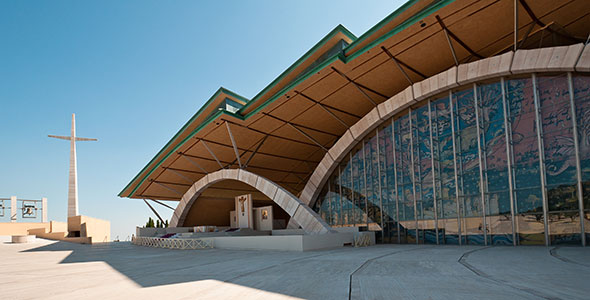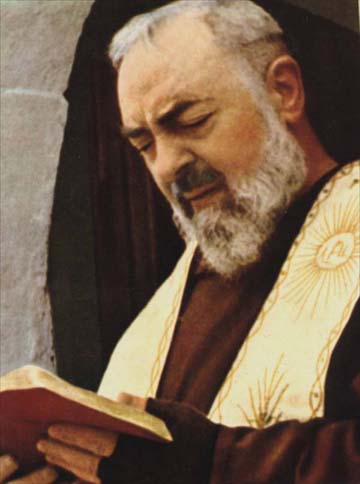The “Road of Pilgrims” that runs to the Arcangelo Michele Grotto in San
Giovanni Rotondo was created in the late 1800s. San Giovanni Rotondo is
now famous all over the world as the native city of St. Pio (meaning
Pius, and known in Italian as Padre Pio) of Pietrelcina, and as the city
where the venerated monk worked his miracles. Pio was beatified in 2002,
and it was he who founded the Sanctuary adjacent to the ancient Convent
of Santa Maria delle Grazie. Next to the Convent a second, larger Sanctuary (designed
by noted architect Renzo Piano) was inaugurated on July 1, 2004.
Originally built in 1540, the Capuchin Monastery is the site
where the Saint lived from September, 1916 until his death in September
1968. It was here that Pio received the stigmata in 1918, and
where all those supernatural events that led to his sainthood and
canonization took place as well. Visiting this Monastery and viewing the
chambers where St. Pio conducted his life means jumping into a context
of spirituality and mysticism; it is a destination that the devout and
tourists alike should make every effort to visit.
Next to the Monastery rises the Church of Santa Maria delle Grazie,
originally dedicated to Santa Maria degli Angeli, consecrated in 1629.
Inaugurated in 1959, thanks to the perseverance and passion of Pio, the old
Sanctuary welcomed the thousands of faithful and pilgrims that
arrived in droves everyday. They came to this small Apulian village to
see the places where the Saint lived out his faith, up until the
realization of the new Church. The Church’s crypt also hosted, up until
a few years ago, the tomb of St. Pio, now found inside the crypt of the
new adjacent complex.
Long dedicated to Santa Maria delle Grazie, the new Sanctuary conceived
by Renzo Piano occupies – with its enormous conch-shell structure
– approximately 6,000 sq.m. (64, 584 sq. ft.) and represents the
second-largest church in Italy after Milan's Duomo. Finally opened after
ten years of construction, and also known as the Church of St. Pio, the
new Sanctuary was almost entirely financed by the offerings of pilgrims.
Today it can hold up to 6,500 people at once.
By the request of Pio, the Church, whose walls are composed of stone
from Apricena, was to be used as a place of welcome for the faithful:
the external churchyard, in fact, features details and characteristics
that repeat on the church’s interior – corresponding floor designs were
planned to emphasize harmony between the exterior and interior. This
choice is also evident in the separation of the two environments by a stained-glass
window decorated with scenes from the Apocalypse. On the Church’s
subterranean level is located a lower church (similarly to the Basilica
of St. Francis of Assisi) where the remains of the Saint reside. The
roof, of oxidized copper, confers to the structure its characteristic
green color.
This profound mixture of historic, religious and architectonic elements
render the Sanctuaries of Padre Pio an indubitable point of
interest for all, including those who are not particularly devout, or
who may not profess any faith at all.
Saint Padre Pio,
pray for us!
Please help
the Padre Pio foundation in this world
of pain and hunger Please donate, all donations are tax deductible. Thank you.
Home
|
Contact
|
People under Padre Pio
|
Padre Pio's Prayers
|
Padre Pio's Rosary
Padre Pio the Saint|
Padre Pio's Relics | Padre
Pio's Miracles
|
Padre Pio's Bio
Padre
Pio's Knowledge
|
Padre Pio's Spiritual Life
|
Padre Pio exhumed
Padre Pio said |
Padre Pio Quotes|
Padre Pio
The path less taken|
St. Pio of Pietrelcina
Padre Pio Pictures |
Padre Pio bilocation |
Padre Pio Healing
Padre Pio Supernatural |
Padre Pio Perfumes |
Padre Pio Levitation
Padre Pio Apparition |
Padre Pio Guardian Angel
|
Padre Pio and the Devil
Padre Pio Confession |Padre
Pio
Pio of Pietrelcina
|
Padre Pio Little
Known Stories
Padre Pio
Sanctuary |
Padre Pio Tales of Mystery |
Padre Pio Bring my Weapon
Padre Pio's Love
for Mary |
Padre Pio Journey to Holiness |
Padre Pio in the Modern Age
Padre Pio
Purgatory |
Padre Pio the Saint |
Padre Pio Priest and Victim | The
Ten Commandments
Padre Pio and the
Padre Pio Foundation all Rights
Reserved.


